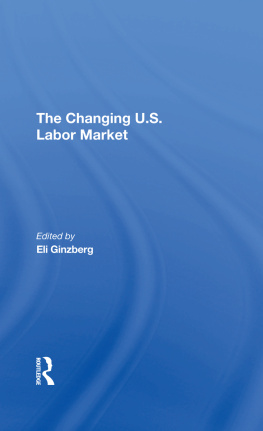Technology and Employment
Technology and Employment
Concepts and Clarifications
Eli Ginzberg ,
Thierry J. Noyelle ,
and Thomas M. Stanback , Jr.
First published 1986 by Westview Press
Published 2019 by Routledge
52 Vanderbilt Avenue, New York, NY 10017
2 Park Square, Milton Park, Abingdon, Oxon OX14 4RN
Routledge is an imprint of the Taylor & Francis Group, an informa business
Copyright 1986 by Conservation of Human Resources, Columbia University
All rights reserved. No part of this book may be reprinted or reproduced or utilised in any form or by any electronic, mechanical, or other means, now known or hereafter invented, including photocopying and recording, or in any information storage or retrieval system, without permission in writing from the publishers.
Notice:
Product or corporate names may be trademarks or registered trademarks, and are used only for identification and explanation without intent to infringe.
Library of Congress Cataloging-in-Publication Data
Ginzberg, Eli, 1911
Technology and employment.
(Conservation of Human Resources studies in the new
economy)
Includes index.
1. Labor supplyUnited StatesEffect of
technological innovations on. 2. Women white collar
workersUnited StatesEffect of technological
innovations on. 3. MicroelectronicsSocial
aspectsUnited States. I. Noyelle, Thierry J.
II. Stanback, Thomas M. III. Title. IV. Series.
HD6331.2.U5G55 1986 331.1'0973 86-5556
ISBN 13: 978-0-367-28965-2 (hbk)
This volume is the first of four publications that will present the research on technology and employment carried out by Conservation of Human Resources of Columbia University over the past several years. This research was started with a small grant from the Rockefeller Foundation in 1982. The original grant was renewed in 1983 by Dr. Bernard Anderson, then head of the Social Sciences Division of the Rockefeller Foundation, so that we could complete the case studies of selected large corporations, which we had started as a way to understand the impacts of the new computer technology on both organizational structures and employment patterns.
In 1983, Conservation of Human Resources, encouraged by the progress made possible by the Rockefeller grant, approached the Ford Foundation for more substantial funding. Our objective was to explore more extensively, through case studies of various sectors, the impact of the computer-communications revolution on the employment of different groups of workers, especially women and minorities, who might be particularly vulnerable to the changes under way. In the summer of 1985, we received additional modest funding from the Ford Foundation to enable us to complete the writing of the four emerging monographs. In our relations with the Ford Foundation, we have had the benefit of sympathetic understanding and critical assistance from Susan Berresford, vice president for United States and International Affairs Programs, and Gordon Berlin, program officer, which we gratefully acknowledge.
During the course of our research, we profited from periodic discussions with two of our colleagues, Thomas Bailey and Anna Dutka, which we gratefully acknowledge.
The core members of the Conservation staff who collaborated on these studies consisted of Dr. Thierry Noyelle and Professor Thomas M. Stanback, Jr., with my continuing involvement in selected phases of the planning, analysis, and writing. For this book, Dr. Noyelle wrote is an integrated product for which we assume joint responsibility. The ideas that we present and the conclusions that we reach are the outcome of a collegial process.
is based on one of our progress reports to the Ford Foundation and represents an attempt to conceptualize what we have learned about the pace and impact of the new technology on employment, particularly on the employment of women and minorities. Although the chapter provides selective empirical insights from our field investigations, its thrust is on conceptualization. Our three other monographs will provide in-depth accounts of these field studies.
provide the reader with a firm foundation from which to explore and assess changes that the new technology is bringing in its wake.
were written at the specific request of the Panel on Technology of the Committee on Women's Employment of the National Academy of Sciences. The chapters deal with separate, but related, aspects of the impact of the new technology on female workers. Specifically, they analyze the extent to which established approaches to Equal Employment Opportunity (EEO) may need to be modified in light of changes brought about by the new technology. A major analytical linkage between the two chapters is the increasing determination of employers to hire new workers with more capacities and competencies and the vulnerability and danger that this poses to less-educated women and minorities.
has become the minimum requirement for employment in most business service enterprises on which New York City's recovery has been based.
In , we consider directions for policy, including existing mechanisms and instrumentalities as well as new ones that should be put in place so that the considerable number of workers, old and new, whose employability is threatened by the new technology have a better chance of finding and keeping jobs in the years ahead. The alternative to strengthening the labor market infrastructure and linking it more effectively to the educational system is to turn our backs on improving job prospects for the disadvantaged and the displaced and to restrict ourselves to assisting them through welfare and other forms of income transfers. As our society continues to value the work ethic, keeping large numbers of displaced and disadvantaged workers on the dole for decades should not be our policy of choice.
Eli Ginzberg, Director
Conservation of Human Resources,
Columbia University
1
A Pass at Conceptualization
Four principal questions are raised at the outset of this chapter: (1) What makes the current phase of computerization qualitatively different from that which preceded it? (2) How can we assess the pace and scope of diffusion of the new technology? (3) What are the determinants of the pace and scope of diffusion? (4) What is the impact of the new technology on employment, especially on the employment of women and minority workers who have traditionally been at a disadvantage?
In order to assess the nature of the transformations that are being brought about by the new generation of microprocessing and distributed data processing technology, it is helpful to contrast the emerging era with the one that preceded it and that began with the introduction of the first commercial computers in the late 1950s.
The first stage of commercial computer technology was primarily directed at putting in place large number-crunching machines that were able to do a great many calculations at high speed and at steadily lower unit cost. The mainframe computer became the recordkeeping war-horse for large companies, and the data processing service bureaus performed many of the same tasks for a great number of middle- and small-sized companies. This new number-crunching capability provided U.S. businesses with a much-improved way to stay on top of many administrative functions, especially those with a heavy clerical content, from order taking and recordkeeping to billing, accounts receivable, and general ledger.










